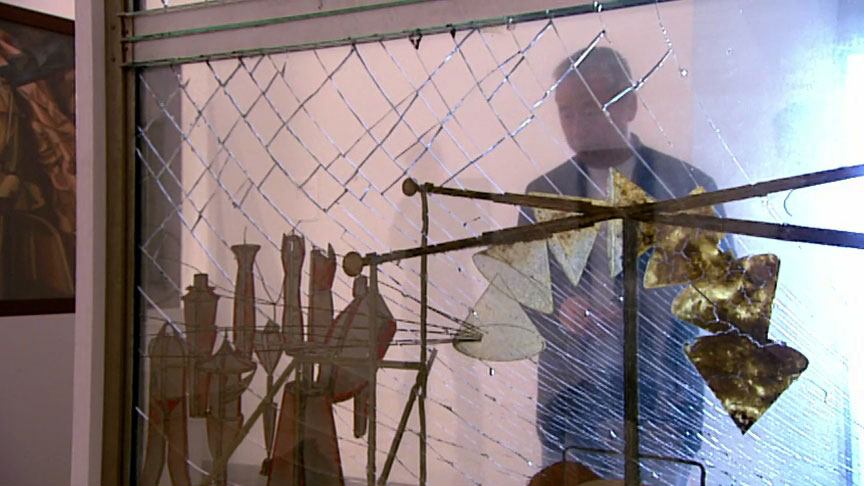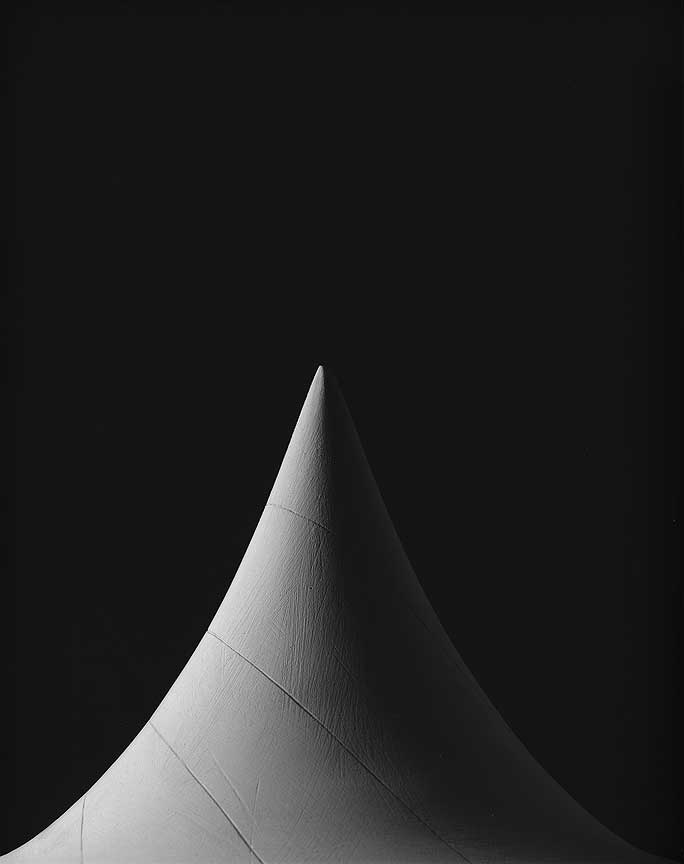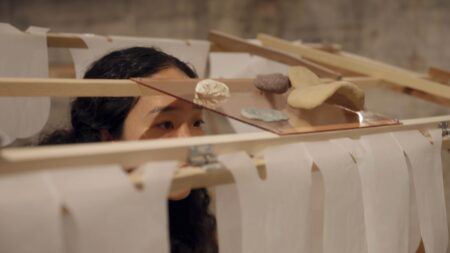Interview
Marcel Duchamp’s Influence

Hiroshi Sugimoto viewing Marcel Duchamp's The Bride Stripped Bare by Her Bachelors, Even (The Large Glass) (1915–23) at the Philadelphia Museum of Art, 2004. Production still from the Art in the Twenty-First Century Season 3 episode, Memory, 2005. © Art21, Inc. 2005.
Hiroshi Sugimoto discusses his process for designing exhibitions, and the role that Marcel Duchamp’s work and ideology plays in his own artistic process.
ART21: Is it a new thing for you, designing exhibitions?
SUGIMOTO: [For] every museum show, I try to design the space. It’s very important. It’s not just a photography show; it’s more like I’m designing the space. I just want to point out where exactly my piece has to be hanged, or against what color, what height, what kind of wall conditions. It’s just like a space sculpture. It costs a lot of money to do it, but I put it as a condition to do a show. I have to be there to fill the space. The height of the ceiling, and then the height of the wall—how much space is between the ceiling and the top of the wall—and then just wide enough for the wheelchair people to go through . . . many factors.
ART21: Do you think sculpturally?
SUGIMOTO: Yes, exactly—it’s a three-dimensional presentation. But with photography, another factor is the time concept. Adding the time concept—this is like Duchamp—a four-dimensional presentation.
ART21: Talk about why you worked from a replica of Marcel Duchamp’s The Bride Stripped Bare By Her Bachelors, Even (The Large Glass).
SUGIMOTO: My intention was to make a replica of a replica. So, mine is a third-generation copy of the original, but mine is even smaller. I used my 8-by-10 camera and photographed the upper part and bottom part, made a negative and a contact print out of the negative. I made negative and positive prints sandwiched with very thick glass.
ART21: Do you find the replica differs from Duchamp’s original?
SUGIMOTO: here are four replicas of The Large Glass—two in Stockholm, one in London, one in Tokyo. I’ve been photographing the replica in Tokyo, spending so much time with the replica that facing the original is a very strange feeling. The original has an enormous power, compared to the replica. A replica is a replica; it’s a copy, a duplicate. Duchamp’s concept of a copy was that the copy is as important as the original. But it’s not true. The original has its own Duchamp spirit in itself, even though he might say, “Well, this is not special at all.” He probably didn’t believe in spirits. But I do feel it.
ART21: What is the element that’s missing, then?
SUGIMOTO: Well, it’s an element added, not missing. It’s a concept of time.

Hiroshi Sugimoto in his Manhattan studio, 2004. Production still from the Art in the Twenty-First Century Season 3 episode, Memory, 2005. © Art21, Inc. 2005.
ART21: How does your photographic replica relate visually to Duchamp’s original?
SUGIMOTO: Probably, it was Duchamp’s intention to have glass that’s transparent. It’s very hard to concentrate on the image—everything is in the surface. So, for my piece, the Tokyo version, I think I betrayed his wishes. I covered The Large Glass with a huge black tent, so that the image is clearly visible because it’s against the black background. Then I photographed it so it’s very transparent. And then my negative serves as a positive because it’s just black background. As a negative, it’s pure transparent glass. So, mine is back to the original, even though it’s reversed, negative and positive.
ART21: Your version, indirectly, even attempts to mimic the cracks in Duchamp’s original.
SUGIMOTO: Cracks, yes, that’s very good. I made the models of the show with the plastic case covered. I sent it to Paris months ago. And then I found it arrived cracked, the case itself. So, this is a good sign. (LAUGHS) This is approval from Duchamp, from up there.
ART21: You are using Duchamp’s concept of both the multiple and the found object, here.
SUGIMOTO: Photography is like a found object. A photographer never makes an actual subject; they just steal the image from the world. So, it’s basically a found object. I am following his theory and tradition. And this is also a found object, Duchamp’s replica. So, it’s a double faking or double replica, in a way. And then I’m also making it multiple, so it’s repeated and repeated, again and again.
ART21: Are you using the same proportions as in the original?
SUGIMOTO: I wonder whether the Tokyo replica really is exactly the same or not. Maybe it’s just a quarter of an inch off or something, because of the material that they used in the 1910s, ’20s, and ’30s, the different kind of glass materials. It’s probably slightly different, but I’m trying to follow the same proportions as much as possible.

Hiroshi Sugimoto viewing Marcel Duchamp’s The Bride Stripped Bare by Her Bachelors, Even (The Large Glass) (1915–23) at the Philadelphia Museum of Art, 2004. Production still from the Art in the Twenty-First Century Season 3 episode, Memory, 2005. © Art21, Inc. 2005.
ART21: You seem to feel a deep connection to Duchamp’s work.
SUGIMOTO: It is exactly thirty years ago since I first came to see Duchamp’s Large Glass. At that time, I wasn’t aware that Marcel Duchamp’s works somehow related to the artwork that I was going to make. I had no sense of close relationship. I didn’t have any sense of being influenced by Duchamp. But now, I have a very strong feeling of a kind of power I received from his work. I recognize it and am more and more aware of it.
And the more I think about it, there’s this long story—the history of painting and the invention of photography in the early nineteenth century. When photography was invented, all the artists were shocked; the painters actually panicked. They thought they may lose their jobs because photography could do better, drawing the actual world. That’s how the European painting movements from Impressionism to Dada began. Painters started to think, “How should we do this differently from photography?” That guided the painter’s mind to a more abstract mind. Duchamp’s Nude Descending a Staircase—the naked woman running down the staircase—that’s the presentation of the concept of time and movement. This is all related to photography. So, that’s how I link the history of painting and photography together.
ART21: It also ties together time and memory.
SUGIMOTO: Memory and replica. Photography is a system of saving memories. It’s a time machine, in a way, to preserve the memory, to preserve time. That’s something I learned from the Duchamp concept.
ART21: Talk about how you photographed the mathematical models.
SUGIMOTO: Well, you never know how big the model is. It’s actually small, probably ten to twelve inches. In my previous career, I learned how to make a lousy building look bright. So, I apply this technique that I actually invented.
ART21: You imagined it would be on this scale?
SUGIMOTO: Yes, I knew that this would look like this—gigantic, monumental. That’s what I wanted to make.
ART21: Why make these small things become so large?
SUGIMOTO: I’m looking for a sculptural quality, like Greek monumental sculpture or even Greek architecture. People tend to lose the sense of how big, how far away the thing is. After I mastered controlling this sense of the space, then I could start playing around with it. Space is a very important factor in photography.
This looks like a Greek vase or even a sculpture. This third one is very much like [the] Venus de Milo, and this is not Greek; it’s Roman. The second one almost looks like Frank Lloyd Wright’s Guggenheim building or the Frank Gehry building. So, it’s somehow related to a sense of old civilizations: Greek, Roman, East Asian, Indian. And it’s very interesting. They are purely mathematical figures, but they remind us to think backwards to the ancient civilizations.

Hiroshi Sugimoto. 0009 Conic surface of revolution with constant negative curvature, 2004. Gelatin-silver print; Image size: 58 3/4 × 47 inches, Frame size: 71 × 60 inches. Edition of 5. Courtesy of the artist and Pace Gallery, New York.
ART21: How did the mathematicians come up with this model?
SUGIMOTO: This is purely what the mathematicians came up with—a purely abstract concept of mathematics. I’m not very good at mathematical thinking, but it’s amazing how it appears to be visually three-dimensional. This is the projected image of a mathematician’s thinking. So, no such thing actually exists in nature; it’s purely a human’s mind that comes to this kind of theory. And then this theory is projected onto this three-dimensional form. We are human, and we are the weirdest creatures: we come up with this, and even a god couldn’t create this. God created nature, but we created conceptual forms.
ART21: Do you think these forms have an emotional significance, as well as a mathematical one?
SUGIMOTO: The mathematicians, I don’t know whether they carry these emotions or not. As an artist, I project my vision onto these mathematical and purely abstract forms. It’s very strange that we want to see things the way we want to see them. This is art, and we can shape what we want to see and how we want to see things.
ART21: Did you know what the photograph would look like?
SUGIMOTO: As a photographer, I have already envisioned how I wanted to see this object. So, probably, I am looking at this the way I want to see. Actually, Man Ray did a series of photographs using the same cast model (not the very piece I found in Tokyo, but the one that belongs to the Poincaré Institute in Paris). It’s been published. I found that out after I started to do this. I am quite convinced that I’m looking at these objects in a very different way from Man Ray. Man Ray was a colleague and very good friend of Marcel Duchamp’s. So, Duchamp must have seen these objects; so again, Duchamp is very related.
ART21: Are there any other influences on the images?
SUGIMOTO: It’s just like sculpture. I feel like I’m carving this out of conceptual form. The figures were made without artistic motivation, and I’m trying to make them art-like. So, that’s photography! People tend to believe that photography can just record scenes. But this is more like using my camera and then projecting my own imagination onto the surface of this “sculpture,” these models. So, I think I feel more like I’m shaping the forms, using a camera instead of [a] chisel. It’s sculptural form using my camera as a tool. And between chisel and camera, there’s no difference to me.
ART21: Do you want to add anything?
SUGIMOTO: I’m very interested in the early-twentieth- and nineteenth-century movements of modernism—how we started living in the way we live now, a more modern life. We’d been living in a very different style of life, and all of a sudden there was the nineteenth-century Machine Age and then the twentieth century. The development of science and religious practices became less and less important. Then the artist moved in and started taking an important role, leading from religious practice and then more independently. This era, 1910–20s, or back in the late nineteenth century, that’s my area of fascination. The more I studied it, the more I got involved. This also happened to be Duchamp’s time.

Hiroshi Sugimoto. 0026 Worm gear, 2004. Gelatin-silver print; Image size: 58 3/4 × 47 inches, Frame size: 71 × 60 inches. Edition of 5. Courtesy of the artist and Pace Gallery, New York.
ART21: You studied this in college?
SUGIMOTO: I was in California in 1973–74; that was the flower children movement. I was really into that. (LAUGHS) I didn’t pay much attention to serious art. Only after I moved to New York in 1974 did I start realizing how important and interesting art can be. But my flower-child time, that really gave me a good education. I met so many interesting, weird people in California—free spirits. It was very, very different from my life in Japan.
ART21: They sparked your imagination?
SUGIMOTO: When I was a college student in Tokyo, I studied German philosophy, Marxist economics, and Hegel and Kant. I was trying to catch up on Western philosophy. And then when I moved to California, everybody was talking about Zen and Buddhism. So, all of a sudden I was rushing to study my background, as someone Japanese. So, I spent three years in California studying Oriental philosophy to catch up, actually.
ART21: Do you see a connection between Marxism and Dada or Surrealism?
SUGIMOTO: Socialism and communism now are considered a kind of failed theory or thinking. But at that time, that was one theory of how people could live together peacefully and nicely. In the nineteenth and twentieth centuries, we had so many bad things happen. The First World War occurred, and then something was wrong with the economic system. A small group of people was getting richer, and most of the people suffered from this. That was from Western thinking—philosophy and social studies. Most of the intelligent people really believed in socialism and then communism. Idealism in general, and Surrealism and Dada—they were trying to stretch the expansion of the human ability, to see things in a different way. So, they are all kind of ambitious, in a way.



